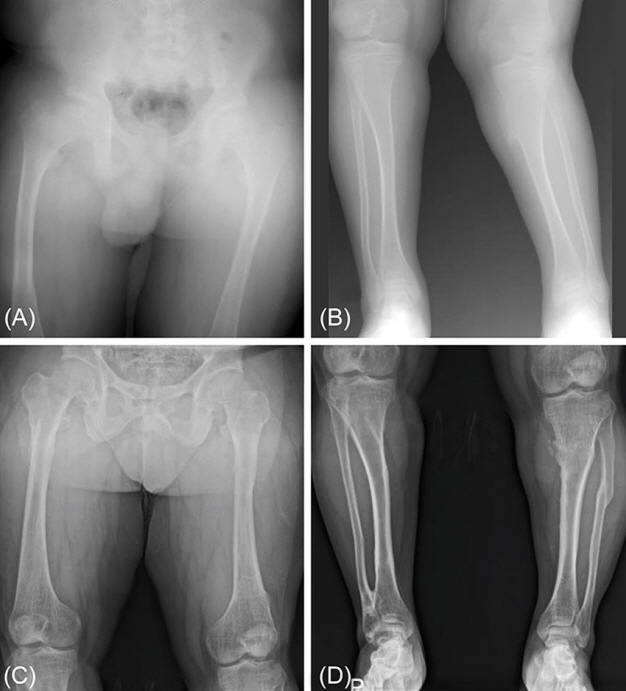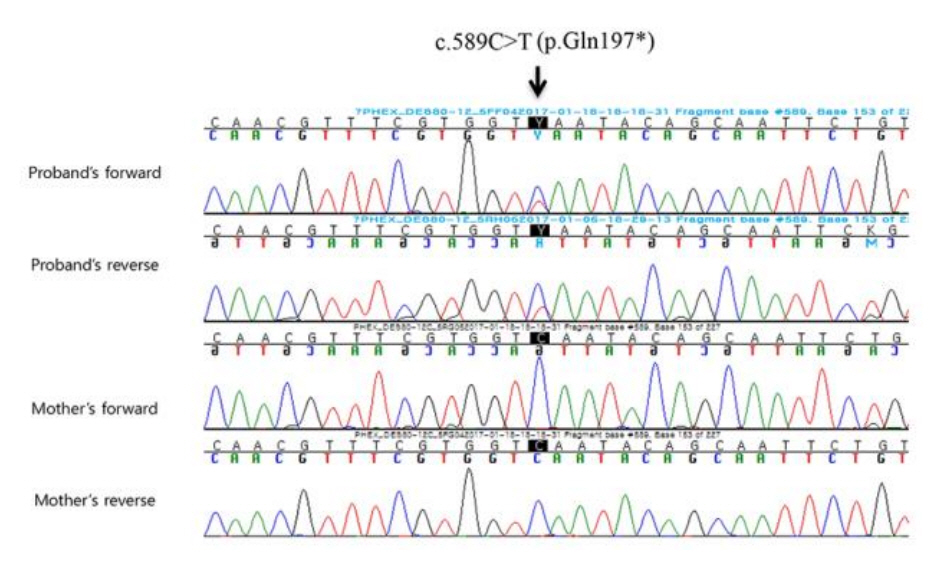Ann Pediatr Endocrinol Metab.
2018 Dec;23(4):229-234. 10.6065/apem.2018.23.4.229.
A novel de novo mosaic mutation in PHEX in a Korean patient with hypophosphatemic rickets
- Affiliations
-
- 1Department of Pediatrics, Samsung Medical Center, Sungkyunkwan University School of Medicine, Seoul, Korea. nadri1217@naver.com, jindk@skku.edu.
- 2Department of Pediatrics, Hanyang University Guri Hopistal, Hanyang University College of Medicine, Guri, Korea.
- 3Department of Pediatrics, Inha University School of Medicine, Incheon, Korea.
- 4Green Cross Genome, Yongin, Korea.
- 5Department of Radiology, Samsung Medical Center, Sungkyunkwan University School of Medicine, Seoul, Korea.
- KMID: 2432276
- DOI: http://doi.org/10.6065/apem.2018.23.4.229
Abstract
- X-linked hypophosphatemic rickets is caused by loss-of-function mutations in PHEX, which encodes a phosphate-regulating endopeptidase homolog. We report a 26-year-old man with X-linked hypophosphatemic rickets who showed decreased serum phosphate accompanied by bilateral genu valgum and short stature. He had received medical treatment with vitamin D (alfacalcidol) and phosphate from the age of 3 to 20 years. He underwent surgery due to valgus deformity at the age of 14 and 15. Targeted gene panel sequencing for Mendelian genes identified a nonsense mutation in PHEX (c.589C>T; p.Gln197Ter) and a mosaic pattern where only 38% of sequence reads showed the variant allele. This mutation was not found in his mother, who had a normal phenotype. This is a case of a sporadic nonsense mutation in PHEX and up to date, this is the first case of a mosaic mutation in PHEX in Korea.
MeSH Terms
Figure
Cited by 1 articles
-
Identification of a novel variant in the
PHEX gene using targeted gene panel sequencing in a 24-month-old boy with hypophosphatemic rickets
Ha Young Jo, Jung Hyun Shin, Hye Young Kim, Young Mi Kim, Heirim Lee, Mi Hye Bae, Kyung Hee Park, Ja-Hyun Jang, Min Jung Kwak
Ann Pediatr Endocrinol Metab. 2020;25(1):63-67. doi: 10.6065/apem.2020.25.1.63.
Reference
-
References
1. Kim J, Yang KH, Nam JS, Choi JR, Song J, Chang M, et al. A novel PHEX mutation in a Korean patient with sporadic hypophosphatemic rickets. Ann Clin Lab Sci. 2009; 39:182–7.2. Francis F, Strom TM, Hennig S, Böddrich A, Lorenz B, Brandau O, et al. Genomic organization of the human PEX gene mutated in X-linked dominant hypophosphatemic rickets. Genome Res. 1997; 7:573–85.3. Kruse K, Woelfel D, Strom TM. Loss of renal phosphate wasting in a child with autosomal dominant hypophosphatemic rickets caused by a FGF23 mutation. Horm Res. 2001; 55:305–8.4. Lorenz-Depiereux B, Benet-Pages A, Eckstein G, Tenenbaum-Rakover Y, Wagenstaller J, Tiosano D, et al. Hereditary hypophosphatemic rickets with hypercalciuria is caused by mutations in the sodiumphosphate cotransporter gene SLC34A3. Am J Hum Genet. 2006; 78:193–201.
Article5. Feng JQ, Ward LM, Liu S, Lu Y, Xie Y, Yuan B, et al. Loss of DMP1 causes rickets and osteomalacia and identifies a role for osteocytes in mineral metabolism. Nat Genet. 2006; 38:1310–5.
Article6. Hasani-Ranjbar S, Amoli MM, Ebrahim-Habibi A, Dehghan E, Soltani A, Amiri P, et al. SLC34A3 intronic deletion in a new kindred with hereditary hypophosphatemic rickets with hypercalciuria. J Clin Res Pediatr Endocrinol. 2012; 4:89–93.
Article7. Brakemeier S, Si H, Gollasch M, Höffler D, Buhl M, Köhler R, et al. Dent's disease: identification of a novel mutation in the renal chloride channel CLCN5. Clin Nephrol. 2004; 62:387–90.
Article8. Song HR, Park JW, Cho DY, Yang JH, Yoon HR, Jung SC. PHEX gene mutations and genotype-phenotype analysis of Korean patients with hypophosphatemic rickets. J Korean Med Sci. 2007; 22:981–6.
Article9. Kang YE, Hong JH, Kim J, Joung KH, Kim HJ, Ku BJ, et al. A novel PHEX gene mutation in a patient with sporadic hypophosphatemic rickets. Endocrinol Metab (Seoul). 2014; 29:195–201.
Article10. Cho HY, Lee BH, Kang JH, Ha IS, Cheong HI, Choi Y. A clinical and molecular genetic study of hypophosphatemic rickets in children. Pediatr Res. 2005; 58:329–33.
Article11. Cheon CK, Lee HS, Kim SY, Kwak MJ, Kim GH, Yoo HW. A novel de novo mutation within PHEX gene in a young girl with hypophosphatemic rickets and review of literature. Ann Pediatr Endocrinol Metab. 2014; 19:36–41.
Article12. Holm IA, Nelson AE, Robinson BG, Mason RS, Marsh DJ, Cowell CT, et al. Mutational analysis and genotype-phenotype correlation of the PHEX gene in X-linked hypophosphatemic rickets. J Clin Endocrinol Metab. 2001; 86:3889–99.
Article13. Popowska E, Pronicka E, Sułek A, Jurkiewicz D, Rowińska E, Sykut-Cegielska J, et al. X-linked hypophosphatemia in Polish patients. 2. Analysis of clinical features and genotype-phenotype correlation. J Appl Genet. 2001; 42:73–88.14. Weng C, Chen J, Sun L, Zhou ZW, Feng X, Sun JH, et al. A de novo mosaic mutation of PHEX in a boy with hypophosphatemic rickets. J Hum Genet. 2016; 61:223–7.
Article15. Goji K, Ozaki K, Sadewa AH, Nishio H, Matsuo M. Somatic and germline mosaicism for a mutation of the PHEX gene can lead to genetic transmission of X-linked hypophosphatemic rickets that mimics an autosomal dominant trait. J Clin Endocrinol Metab. 2006; 91:365–70.
Article16. Jagtap VS, Sarathi V, Lila AR, Bandgar T, Menon P, Shah NS. Hypophosphatemic rickets. Indian J Endocrinol Metab. 2012; 177–82.
Article17. Linglart A, Biosse-Duplan M, Briot K, Chaussain C, Esterle L, Guillaume-Czitrom S, et al. Therapeutic management of hypophosphatemic rickets from infancy to adulthood. Endocr Connect. 2014; 3:R13–30.
Article18. Zhang X, Imel EA, Ruppe MD, Weber TJ, Klausner MA, Ito T, et al. Pharmacokinetics and pharmacodynamics of a human monoclonal anti-FGF23 antibody (KRN23) in the first multiple ascending-dose trial treating adults with X-linked hypophosphatemia. J Clin Pharmacol. 2016; 56:176–85.
Article19. Chen CP, Lin SP, Su YN, Chern SR, Su JW, Wang W. Prenatal diagnosis of recurrent autosomal dominant osteogenesis imperfecta associated with unaffected parents and paternal gonadal mosaicism. Taiwan J Obstet Gynecol. 2013; 52:106–9.
Article
- Full Text Links
- Actions
-
Cited
- CITED
-
- Close
- Share
- Similar articles
-
- A novel de novo mutation within PHEX gene in a young girl with hypophosphatemic rickets and review of literature
- PHEX Gene Mutations and Genotype-Phenotype Analysis of Korean Patients with Hypophosphatemic Rickets
- A Novel PHEX Gene Mutation in a Patient with Sporadic Hypophosphatemic Rickets
- A pathogenic PHEX variant (c.1483-1G>C) in a Korean patient with X-linked hypophosphatemic rickets
- X-linked Hypophosphatemic Rickets, del(2)(q37.1;q37.3) Deletion Syndrome and Mosaic Turner Syndrome, mos 45,X/46,X, del(2)(q37.1;q37.3) in a 3-year-old Female



